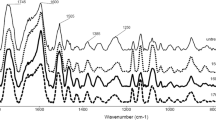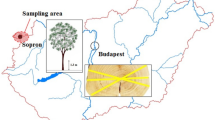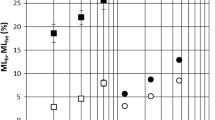Abstract
Wood specimens of Beech (Fagus silvatica L.) and Scots pine (Pinus sylvestris L.) modified by a hydrothermal treatment process were analysed by means of Fourier transform infra red spectroscopy (FTIR). The chemical transformation of the cell-wall material was studied and associated with improved wood qualities. For this purpose, FTIR spectroscopy was used as since this technique has been found appropriate to determine the intensity of specific bonds and functional groups within the polymeric structure. Cleavage of acetyl groups of the hemicellulose has been found to occur in the first treatment step under moist conditions and elevated temperature. This results in the formation of carbonic acids, mainly acetic acid. Most of the acetyl groups were found to be cleaved during the treatment of wood at high temperature, whereas only partial deacetylation was found to occur at moderate treatment temperature. The concentration of accessible hydroxyl groups was measured by acetylation and found reduced after treating at high temperature. Esterification reactions were found to occur under dry conditions at elevated temperature in the curing step, indicated by the increase of the specific ester carbonyl peak at 1740 cm−1 in the FTIR spectrum. The esters that were formed turned out to be mainly linked to the lignin complex, considering that the newly formed carbonyl groups were found present in heat-treated wood, yet were found to be absent in the isolated holocellulose. Esterification contributes to a decrease of hygroscopicity of wood and consequently improvements of its dimensional stability and durability. However, the role of esterification in the decrease of hygroscopicity in the hydrothermal treatment process examined is believed to be minor compared to the influence of cross-linking reactions known to occur during thermal treatment of wood.
Zusammenfassung
Das Holz hydrothermisch modifizierten Buchen- und Kiefernholzes wurde mit FTIR Spektroskopie untersucht. Die chemischen Veränderungen wurden mit dem Hintergrund veränderter Holzeigenschaften diskutiert. Abspaltungen von Acetylgruppen der Hemicellulosen finden vor allem bereits im ersten Prozessschritt unter feuchten Bedingungen und bei erhöhten Temperaturen statt. Dieses führt zur Bildung von Essigsäure und anderen Carbonsäuren. Bei niedrigeren Temperaturen werden weniger Carbonsäuren freigesetzt. Durch Acetylierung wurde der Gehalt an freien Hydroxylgruppen bestimmt. Durch die Hitzebehandlung reduziert sich der Gehalt freier Hydroyxlgruppen. Die Zunahme des Carbonylesterpeaks bei 1740 cm−1 im FTIR Spektrum lässt sich durch Veresterungsreaktionen im heißen aber trocknen Curingschritt erklären. Diese Ester sind vor allem an den Ligninkomplex gebunden und weniger an die Holocellulose. Durch Veresterungen wird ein hygroskopisches, dimensionsstabiles und dauerhaftes Material geschaffen. Die Veränderung der Materialeigenschaften beruht jedoch vor allem auch auf cross-linking Reaktionen die während des Prozesses ablaufen.






Similar content being viewed by others
References
Bobleter O, Binder H (1980) Dynamischer hydrothermaler Abbau von Holz. Holzforschung 34:48–51
Boonstra MJ, Tjeerdsma BF, Groeneveld HAC (1998) Thermal modification of non-durable wood species. 1. The PLATO technology: thermal modification of wood. International Research Group on Wood Preservation, Document no. IRG/WP 98-40123
Bourgois J, Guyonnet R (1988) Characterization and analysis of torrified wood. Wood Sci Technol 22:143–155
Browning BL (1967) Methods of wood chemistry. John Wiley Sons, Inc., New York, 882p.
Burmester A (1973) Einfluß einer Wärme-Druck-Behandlung halbtrockenen Holzes auf seine Form-beständigkeit. Holz Roh- Werkstoff 31:237–243
Burmester A (1975) Zur Dimensionsstabilisierung von Holz. Holz Roh- Werkstoff 33:333–335
Burmester A, Wille WE (1976) Quellungsverminderung von Holz in Teilbereichen der relativen Luft-feuchtigkeit. Holz Roh- Werkstoff 34:87–90
Burtscher E, Bobleter O, Schwald W, Concin R, Binder H (1987) Chromatographic analysis of biomass reaction products produced by hydrothermolysis of Poplar wood. J Chrom 390:401–412
Carrasco F, Roy C (1992) Kinetic study of dilute-acid prehydrolysis of xylan-containing biomass. Wood Sci Technol 26:189–208
Davids WH, Thompson WS (1964) Influence of thermal treatments of short duration on the toughness and chemical composition of wood. Forest Prod J 8:350–356
Dietrichs HH, Sinner H, Puls J (1978) potential of steaming hardwoods and straw for feed and food production. Holzforschung 32:193–199
Dwianto W, Tanaka F, Inoue M, Norimoto M (1996) Crystallinity changes of wood by heat or steam treatment. Wood Research 83:47–49
Ellis S, Paszner L (1994) Activated selfbonding of wood and agricultural residues. Holzforschung 48:82–90
Faix O (1988) Practical uses of FTIR spectroscopy in wood science and technology. Mikrochimica Acta 1:21–25
Faix O, Böttcher JH (1992) The influence of particle size and concentration in transmission and diffuse reflectance spectroscopy of wood. Holz Roh- Werkstoff 50:221–226
Fengel D, Wegener G (1989) Wood: chemistry, ultrastructure, reactions. W de Gruyter, Berlin, 613p
Giebeler E (1983) Dimensionsstabilisierung von Holz durch eine Feuchte/Wärme/Druck-Behandlung. Holz Roh- Werkstoff 41:87–94
Goyal GC, Lora JH (1991) Kinetics of delignification and lignin characteristics in autocatalyzed organosolv pulping of hardwoods. Proc Int Symp Wood Pulp Chem Melbourne, Australia 1:205–212
Hillis WE (1984) High temperature and chemical effects on wood stability. Wood Sci Technol 18:281–293
Kaar WE, Cool LG, Merriman MM, Brink DL (1991) The complete analysis of wood polysaccharides using HPLC. J Wood Chem Technol 11:447–463
Klauditz W, Stegmann G (1955) Beiträge zur Kenntnis des Ablaufes und der Wirkung thermischer Reaktionen bei der Bildung von Holzwerkstoffen. Holz Roh-Werkstoff 13:434–440
Kollmann F (1963) Über das Sorptionsverhalten wärmebehandelter Hölzer. Holz Roh- Werkstoff 21:77–85
Kollmann F, Fengel D (1965) Änderungen der chemischen Zusamensetzung von Holz durch thermische Behandlung. Holz Roh- Werkstoff 23:461–468
Kollmann F, Schneider A (1963) Über das Sorptionsverhalten wärmebehandelter Hölzer. Holz Roh- Werkstoff 21:77–85
Militz H (2002) Heat treatment technologies in Europe: Scientific background and technological state of art. In: Enhancing the durability of lumber and engineered wood products, FPS/Madison US, Conference, Florida 11–13, February 2002
Militz H, Beckers EPJ, Homan WJ (1997) Modification of solid wood: research and practical potential, International Research Group on Wood Preservation, Document no. IRG/WP 97-40098
Noack D (1969) Über die Heißwasserbehandlung von Rotbuchenholz im Temperaturbereich von 100 bis 180 °C. Holzforschung Holzverwertung 21:118–124
Rowell RM (1984) The chemistry of solid wood. American Chemical Society, Washington D.C., 614p.
Rowell RM, Tillman AM, Simonson R (1986) A simplied procedure for the acetylation of hardwood and softwood flakes for flakeboard production. J Wood Chem Technol 6:427–448
Runkel ROH (1951) Zur Kenntnis des thermoplastischen Verhaltens von Holz. Holz Roh- Werkstoff 9:41–53
Runkel ROH, Witt H (1953) Zur Kenntnis des thermoplastischen Verhaltens von Holz. Holz Roh- Werkstoff 11:457–461
Ruyter HP (1989) European patent Appl. No. 89-203170.9
Seborg RM, Tarkow H, Stamm AJ (1953) Effect of heat upon the dimensional stabilisation of wood. J For Prod Res Soc 3:59–67
Sjöström E (1981) Wood chemistry: fundamentals and applications. Academic Press, Inc. San Diego, 293p.
Stamm AJ (1956) Thermal degradation of wood and cellulose. Ind Eng Chem 48:413–417
Tjeerdsma BF, Boonstra M, Pizzi A, Tekely P, Militz H (1998a) Characterisation of thermal modified wood: molecular reasons for wood performance improvement. CP-MAS 13C NMR characterisation of thermal modified wood. Holz Roh- Werkstoff. 56:149–153
Tjeerdsma BF, Boonstra M, Militz H (1998b) Thermal modification of non-durable wood species. 2. Improved wood properties of thermally treated wood. International Research Group on Wood Preservation, Document no. IRG/WP 98-40124
Tjeerdsma BF, Stevens M, Militz H (2000) Durability aspects of hydrothermal treated wood. International Research Group on Wood Preservation, Document no. IRG/WP 00-4
Wise LE, Murphy M, D’Addieco AA (1946) Pap Trade J 122(2):35–43
Acknowledgements
The authors would like to thank Karel van der Heijden, Clarine Sieger and Bas Holleboom for their experimental assistance.
Author information
Authors and Affiliations
Corresponding author
Rights and permissions
About this article
Cite this article
Tjeerdsma, B.F., Militz, H. Chemical changes in hydrothermal treated wood: FTIR analysis of combined hydrothermal and dry heat-treated wood. Holz Roh Werkst 63, 102–111 (2005). https://doi.org/10.1007/s00107-004-0532-8
Published:
Issue Date:
DOI: https://doi.org/10.1007/s00107-004-0532-8




